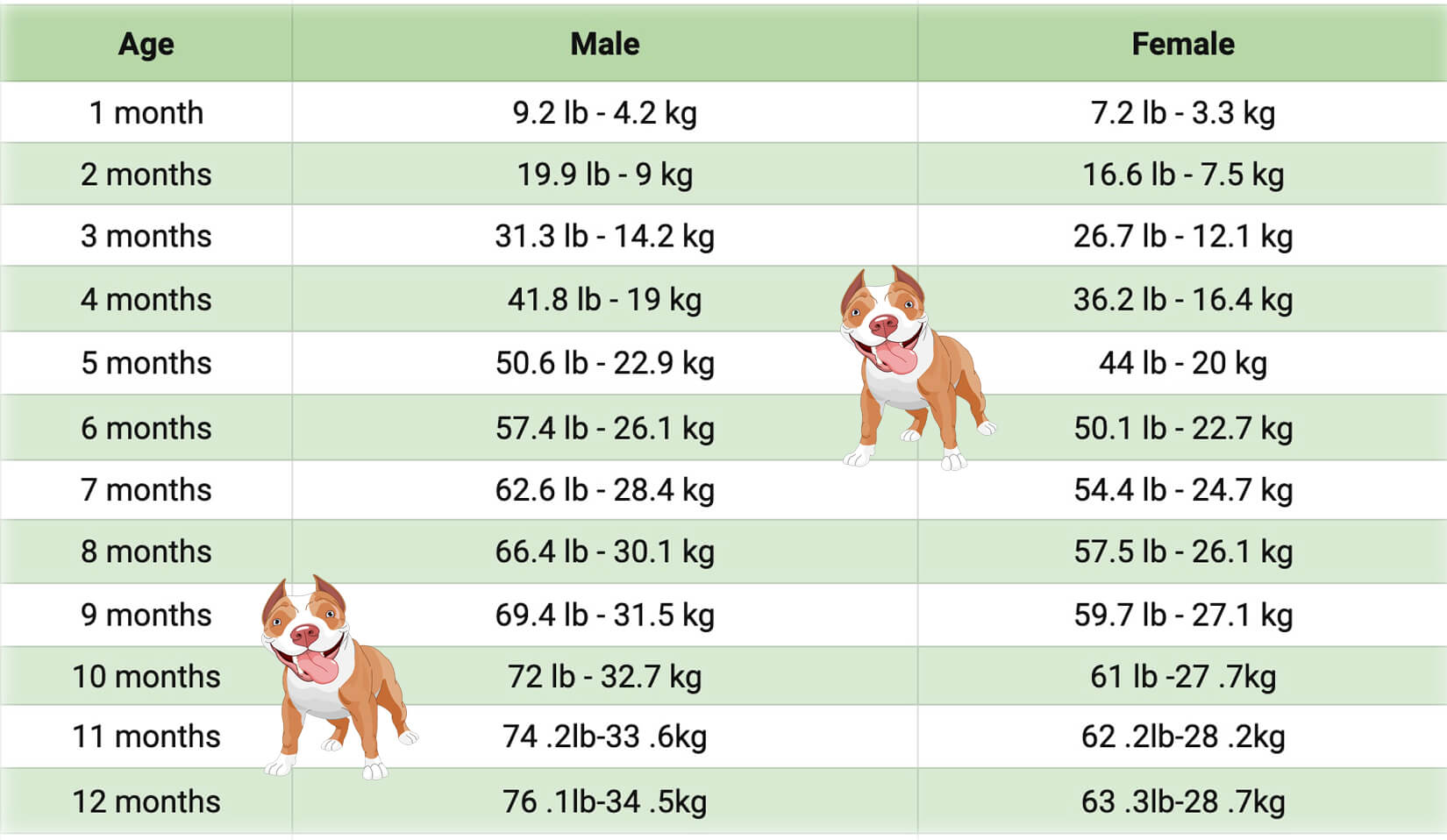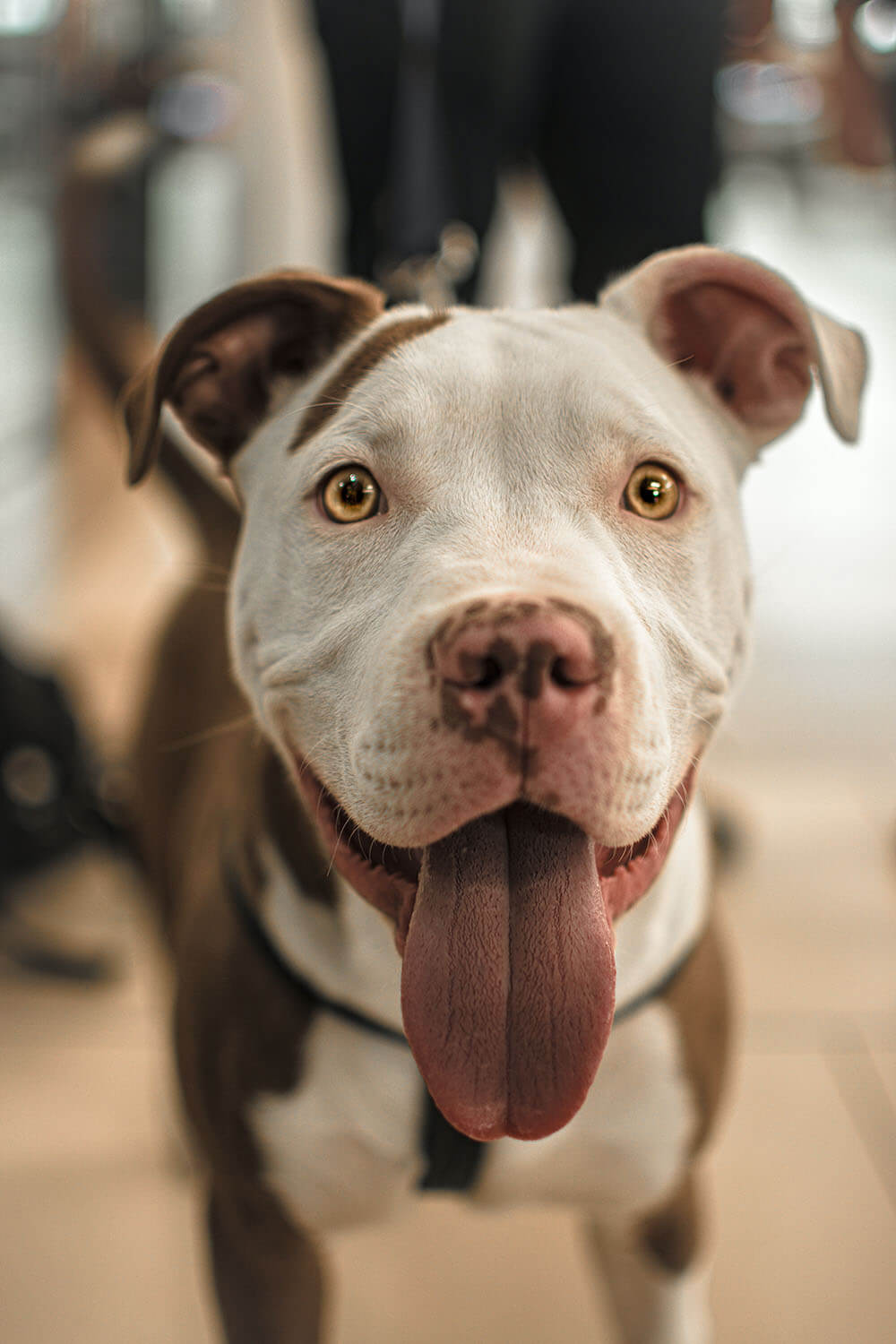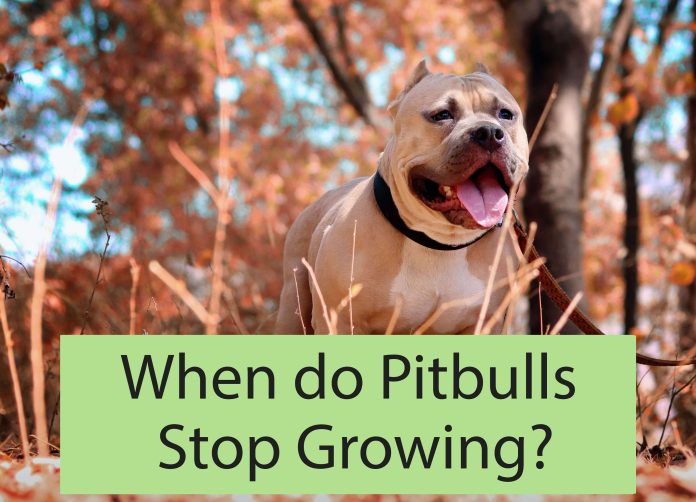If you are a proud owner of a Pitbull puppy, you might be wondering when your furry friend will reach its full size and weight. Pitbulls are a diverse and fascinating breed of dogs that have different growth and development stages depending on their genetics, health, nutrition, and environment. Knowing when do pitbulls stop growing can help you provide the best care and training for your loyal companion. Let’s get started!
The growth and development of pitbulls
Pitbulls are classified as medium-sized dogs, but they can range from small to large depending on their specific type. There are many types of pitbulls, such as American Pit Bull Terriers, American Staffordshire Terriers, Staffordshire Bull Terriers, American Bullies, Pocket Pitbulls and XL Pitbulls.
Each type has its own characteristics, temperament and appearance, but they all share some common traits such as a muscular body, a short coat and a broad head.
The size of a pitbull can be estimated by using a simple formula: double their weight at four months of age. This will give you a rough idea of how much they will weigh as an adult. However, this is only an approximation and some pitbulls may grow faster or slower than others.
To get a more accurate measurement, you can use a pitbull weight chart that lists the average weight of pitbulls at different ages.

Pitbull Growth Process
Like all dogs, pitbulls grow through a process that involves their bones, muscles, organs and hormones. The most important factor that determines their growth is their growth plates, which are soft areas of cartilage located at the ends of their long bones.
Check the best dog food for Pitbull puppies
The growth plates are open and flexible until the puppy reaches maturity, which is usually between one and two years of age. At this point, the growth plates close and harden into solid bone, signaling the end of the growth process.
After reaching their adult height, pitbulls continue to fill out and gain muscle mass until they are about two or three years old. This is when they reach their adult weight and shape.
Choose The Best Dog Food For Pit Bulls To Gain Weight Right here!
How big do Pitbulls get?
To give you a better idea of how big and heavy your Pitbull can be, we have created a Pitbull size chart that shows the average height and weight ranges for the four most common types of Pitbulls: the American Pit Bull Terrier, the American Staffordshire Terrier, the Staffordshire Bull Terrier, and the American Bully.
The chart also shows the average lifespan and temperament of each breed. However, keep in mind that these are only averages and ranges, and individual dogs may vary significantly from them.
|
Breed |
|
|
|
Temperament |
|||||
|---|---|---|---|---|---|---|---|---|---|
|
|
|
|
|
|||||
|
|
|
|
|
|||||
|
|
|
|
|
|||||
|
|
|
|
|
Pitbull’s life cycle
The four major stages of your Pitbull’s life cycle include: puppyhood, adolescence, adulthood, and senior citizen.
Pitbulls go through several stages of development, from birth to adulthood, each with its own characteristics and challenges. Let’s take a look at an overview of the growth stages of Pitbulls:
|
Stage |
Size and Weight |
Feature |
|---|---|---|
|
Birth to 2 weeks |
7 to 10 oz |
This is the neonatal and socialization stage, where the puppies are born blind, deaf, and helpless. They rely on their mother for warmth, food, and protection. |
|
2 – 8 weeks |
2 to 10 pounds |
They start to open their eyes and ears around 2 weeks old, and begin to explore their surroundings and interact with their littermates and humans around 4 weeks old. This is a critical period for socialization, as the puppies learn about the world and form bonds with other dogs and people. The puppies should stay with their mother until at least 8 weeks old, as they need her milk and guidance. |
|
8 weeks to 6 months |
10 to 30 pounds |
They grow rapidly in height and weight, and develop their teeth, muscles, bones, and organs. They also become more active, curious, playful, and energetic. They need a lot of exercise, stimulation, training, and socialization to keep them healthy and well-behaved. This is also a good time to spay or neuter your pitbull, as it can prevent unwanted pregnancies and health issues later in life. |
|
6 months to 2 years |
30 to 60 pounds |
This is the adolescent stage, where the pitbulls reach their sexual maturity and start to show their personality and temperament. They may also become more rebellious, stubborn, or aggressive, as they test their boundaries and challenge their authority figures. They need consistent discipline, guidance, and reinforcement to learn the rules and expectations of their family and society. They also need continued exercise, stimulation, training, and socialization to prevent boredom, frustration, or anxiety. |
|
2 years to 5 years |
60 to 100 pounds |
This is the adult stage, where the pitbulls reach their physical maturity and stop growing in height and weight. They may still gain some muscle mass or fill out in their chest or head area until they are about 3 years old. They also reach their mental maturity and settle into their personality and temperament. They become more calm, confident, and loyal to their owners. |
|
5 years and older |
30 to 90 pounds |
the Pitbulls start to show signs of aging and decline.They may lose some of their muscle mass, bone density, or coat quality.They may also develop some health problems, such as arthritis, cancer, dental issues, or vision loss.They need more care, support, and attention from their owners.They also need less exercise, but more comfort and relaxation |
Factors that influence Pitbull growth
Like another dogs, Pitbull growth is influenced by many factors, such as breed, gender, genetics, nutrition, health, exercise, etc. These factors are:

#1. Breed
Pitbulls are a broad term that covers several breeds and mixes of bull dog sand terriers. Some of the most common types of Pitbulls are the American Pit Bull Terrier, the American Staffordshire Terrier, the Staffordshire Bull Terrier, and the American Bully.
Each breed has its own standards of height and weight, as well as its own genetic traits and characteristics. For example, the American Pit Bull Terrier is the smallest and lightest of the four breeds, averaging between 30 to 65 pounds for males and 30 to 60 pounds for females.
The American Bully is the largest and heaviest of the four breeds, averaging between 70 to 120 pounds for males and 60 to 100 pounds for females.
#2. Gender
Male pitbulls tend to be larger and heavier than female pitbulls, as they have more testosterone and muscle mass. They also tend to grow faster and reach their full size sooner than female pitbulls, who may have a longer growth spurt. Female pitbulls may also lose some weight after spaying or during pregnancy or lactation.
#3. Genes
Your pit bull’s size and growth depend on many factors, and one of them is genes. Genes are the parts of your pit bull’s DNA that control their physical and behavioral characteristics, such as their fur color, eye shape, or body size.
Your pit bull gets genes from both their mom and dad, and each of them gives one version of each gene to their puppy. The mix of these genes can make your pit bull grow faster or slower, and bigger or smaller.
#4. Nutrition
Nutrition:The food you feed your Pitbull is one of the most important factors that influence its growth, as it provides the energy and nutrients it needs to develop and function properly.
You should feed your Pitbull a high-quality dog food that is appropriate for its age, size, and activity level.
You can check the pure balance dog food in here
You should also avoid overfeeding or underfeeding your Pitbull, as both can cause health problems and stunt its growth. Overfeeding can lead to obesity, diabetes, joint issues, or heart problems. Underfeeding can lead to malnutrition, growth retardation, weakness, or immune system issues.

You should also provide your Pitbull with fresh water at all times, and avoid giving it human food such as chocolate, grapes, raisins, onions, garlic, xylitol, or other toxic substances.
#4. Health conditions
The health condition of your pitbull can also affect how big and fast it will grow, as it can impact its metabolism, hormones, and immune system.
If your pitbull suffers from any illness, injury, infection, parasite, or disease, it may slow down or stop its growth until it recovers. Some health issues that can affect pitbull growth are: thyroid problems, worms, mange, distemper, parvovirus, rabies, cancer, etc.
You should also spay or neuter your Pitbull to prevent reproductive health problems and unwanted pregnancies.
#5. Exercise
The amount and type of exercise your Pitbull gets can also influence its growth, as it can stimulate or inhibit its muscle and bone development. Pitbulls are active and energetic dogs that need a lot of exercise to keep them fit and happy.
You should provide your Pitbull with at least an hour of physical activity per day, such as walking, jogging, running, hiking, biking, swimming, playing fetch, tug-of-war, agility, coursing, etc.You should also vary the intensity and duration of the exercise according to your Pitbull’s age, size, and fitness level.
What should you do if your Pitbull is growing too fast?
If your Pitbull is growing too fast, it may be a sign of overfeeding, health problems, or genetic issues. Growing too fast can cause stress on your Pitbull’s bones, joints, and muscles, and increase the risk of injuries and diseases.
Here are some things you can do if your Pitbull is growing too fast:
Adjust your Pitbull’s diet and feeding schedule: If your Pitbull is overweight or obese, you may need to reduce their food intake or switch to a lower-calorie or weight-management dog food.
Following a regular feeding schedule and avoid free-feeding or leaving food out for your Pitbull to eat whenever they want.
Increase your Pitbull’s exercise and activity level
Consult your veterinarian for advice and diagnosis.
How to Tell If Your Pitbull Has Stopped Growing
One of the most common questions that Pitbull owners have is how to tell if their Pitbull has stopped growing. This can be tricky, because there is no definitive answer or test that can tell you for sure. However, there are some signs and methods that can help you estimate if your pitbull has reach edits full size and maturity, such as:
#1 – Measuring its height and weight
One of the simplest ways to tell if your Pitbull has stopped growing is to measure its height and weight regularly and compare them with the breed standards or averages.
You can use a scale or a measuring tape to do this. However, you should keep in mind that these measurements are not always accurate or consistent, due to factors such as posture, muscle mass, body condition, scale calibration, tape stretching, etc.
You can also use a Pitbull growth chart or a Pitbull weight calculator to estimate your Pitbull’s expected size and weight based on its age, breed, and gender above.
#2 – Checking body condition score (BCS)
Another way to tell if your Pitbull has stopped growing is to check its body condition score (BCS),which is a scale that assesses how much fat and muscle a dog has.A healthy BCS for a Pitbull is between 4 -5/9, which means that you can feel their ribs but not see them, and that they have a visible waist and tuck-up.

You can use your hands to palpate your Pitbull’s body and compare it with a BCS chart or guide. However, keep in mind that BCS is not always reliable or objective, due to factors such as fur, breed, frame size, muscle tone, etc.
#3 – Consulting with your veterinarian
The best way to tell if your Pitbull has stopped growing is to consult with your veterinarian, who can examine your Pitbull and perform some tests to determine its age, size, and maturity.
Your veterinarian can also check for any health issues that may affect your Pitbull’s growth, such as thyroid problems, parasites, or diabetes. They can also advise you on how to care for your Pitbull and provide it with the best nutrition, exercise, and supplements for its growth stage and needs.
How to care for your Pitbull throughout its life
Consult your vet
Your vet is your best source of information and advice on your Pitbull’s growth and development. Your vet can monitor your Pitbull’s weight, height, body condition score and overall health throughout their life stages.
Your vet can also recommend the best diet, exercise and supplements for your Pitbull based on their individual needs. Your vet can also perform regular check-ups, vaccinations, deworming and spaying/neutering procedures that can prevent or treat any health issues that may affect your Pitbull’s growth.
Socialize your Pitbull
Socialization is important for the mental and emotional development of your Pitbull as well as for preventing behavioral problems such as aggression, fearfulness or anxiety. Socialization should start as soon as you bring your Pitbull home and continue throughout their life.
You can socialize your Pitbull by taking them to puppy classes, dog parks, pet stores, friends’ houses or any other safe and friendly environment where they can meet new people and animals.
Training Pitbull from an early age
Training is important for the intellectual development of your pitbull as well as for establishing a bond between you and your dog. Training also helps your pitbull become a well-mannered and respectful member of your family and society.
Training should start as soon as you bring your pitbull home and continue throughout their life. You can train your pitbull by using positive reinforcement methods such as praise, treats, toys or playtime. You should avoid using harsh or negative methods such as yelling, hitting or scolding because they can damage your relationship with your dog and cause fear or aggression.
Grooming
Pitbulls are easy to groom dogs that have a short coat that sheds moderately. You should groom your Pitbull regularly to keep its coat clean and shiny.
Common Q&A about When do Pitbulls stop growing
How big should a 6-month-old PitBull be?
A 6-month-old Pit Bull should typically weigh around 25 to 50 pounds, depending on its specific growth rate and genetics.
At what age is a PitBull fully grown?
A PitBull is usually fully grown by around 1 to 1.5 years of age.
Do Pitbull mixes vary in size?
Yes, Pit Bull mixes can vary in size due to the influence of other breeds in their genetic makeup, and health issues depending on the traits they inherit from both parents.
|
Pitbull Mixed |
Parents |
Tall |
Weight |
|---|---|---|---|
|
Pitbull Boxer Mix |
American Pit Bull Terrier and a Boxer |
16 to 20 inches |
50 to 80 pounds |
|
Pit Chow |
American Pit Bull Terrier and a Chow Chow |
17 to 21 inches |
45 to 70 pounds |
|
Pitbull Bull Terrier Mix |
American Pit Bull Terrier and a Bull Terrier |
17 to 22 inches |
55 to 70 pounds |
|
Pitbull Pug Mix |
American Pit Bull Terrier and a Pug |
12 to 15 inches |
20 to 35 pounds |
|
American Pit Bull Terrier and a Chihuahua |
10 to 20 inches |
15 to 35 pounds |
Final thought
Knowing when do Pitbulls stop growing can help you provide the best care and training for your loyal companion. If you have any other questions about Pitbulls or anything else, please comment bellow.

